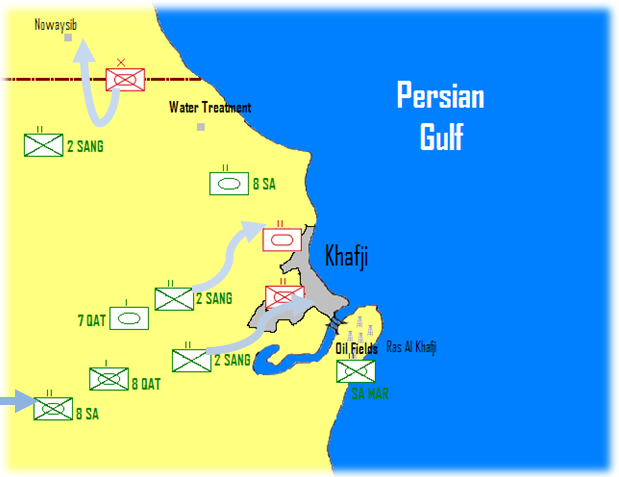
25 years ago today Sadaam Hussein’s elite tank troops crossed the border and attacked the coastal town of Kafji, twelve kilometres into Saudi Arabia. This was a major incursion, by his 1st and 5th Armoured Divisions,with his 3rd Tank Division. Most agree that this was the start of an intended invasion of Saudi Arabia.
Commanded by Major General Salah Aboud Mahmoud, he had upgraded T55 and T62 tanks, some with laminate armour. These survived hits by American Milan anti-tank missiles. They also had armoured artillery, and five infantry divisions waiting in Kuwait as follow up forces – to win ground and occupy. It’s thought that their intention was to capture the valuable Damman oilfields.

This attack came at a dangerous time in the coalition buildup. The US Marines on the coast had just about enough well-prepared defensive positions, but not the tanks needed to defeat the Iraqi force. More critically, inland the rest of the coalition land force was deploying ready for the land war. They were not in anything like battle formations. The British field hospital was out in front of all this, where it needed to be for the land battle, but on its own with no effective self-defence.
In my book British commander General Rupert Smith tells us very frankly how he decided to ignore this threat to the undefended medics, so as not to hinder the complicated deployment to battle positions. He did however go and see them, suggesting they deploy their few machine guns in the direction of the Iraqi invaders.
But thankfully, the Iraqis did not venture inland, and stuck to the coast. They captured the town of Kafji, but not the headland to the south with the Ras al Kafji oil refinery. Their modified plan may then have been to occupy Kafji with the armoured infantry from 5th Armoured Division, wait for the Coalition counter attack, then possibly to retire with prisoners of war to use as bargaining chips in Saddam’s overall bluff-style negotiations.
The invaders were attacked by coalition air strikes, then by US Marine and Army Ranger units on the ground. Nevertheless one of the columns occupied Kafji – an armoured infantry regiment in the main part of the town and a tank battalion on its northern outskirts.

It was decided that Saudi and Qatari forces should be seen to repulse this invasion. And so between 30 January and 1 February, two Saudi National Guard battalions and two Qatari tank battalions aided by coalition air strikes and US artillery, attempted to retake the town. This was achieved at the cost of 43 coalition dead and 52 wounded, and between 60 and 300 Iraqi dead. (Other estimates say that several thousand Iraqi soldiers were killed.) 400 Iraqis were taken prisoner.
Twenty-five Americans were included in the numbers of dead, 11 from a friendly fire incident. So although this battle revealed the “hollowed-out” nature of Iraqi forces and their lack of sustained resistance to determined attack – which was to characterise the land war in just over three week’s time, it also presaged similar friendly fire incidents.
This battle is generally regarded as demonstrating the use of air power in support of a modern land battle.
Saddam had initially heralded the operation as having “expelled Americans from the Arab territory”. But as the battle progressed, this rhetoric faded. The blooding of the Saudis and Qataris gave them and the coalition generally, confidence that they’d be similarly successful in the impending invasion of Kuwait.

Engaged in attacking targets a few miles north of Khafji, an USAF AC-130 gunship (callsign Spirit 03) was hit by an Iraqi surface-to-air missile just after sunrise on 31 January and crashed in the Persian Gulf with its entire 14-person crew.
Khafji was ordered evacuated on 18 August 1990, because it was within range of Iraqi artillery in Kuwait.
Two U.S. Army truck drivers who took a wrong turn wound up in Khafji: Spec. Melissa Rathbun-Nealy and Spec. David Lockett. Both were wounded and captured. Fortunately, both were released on 4 March 1991 after 35 days of captivity.